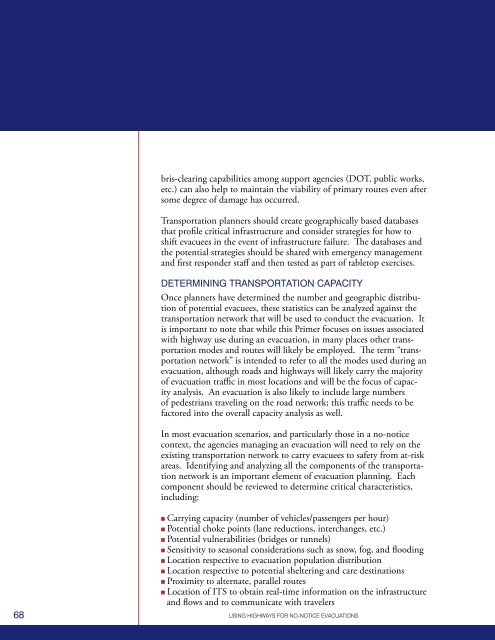using highways for no-notice evacuations - FHWA Operations - U.S. ...
using highways for no-notice evacuations - FHWA Operations - U.S. ...
using highways for no-notice evacuations - FHWA Operations - U.S. ...
You also want an ePaper? Increase the reach of your titles
YUMPU automatically turns print PDFs into web optimized ePapers that Google loves.
is-clearing capabilities among support agencies (DOT, public works,etc.) can also help to maintain the viability of primary routes even aftersome degree of damage has occurred.Transportation planners should create geographically based databasesthat profile critical infrastructure and consider strategies <strong>for</strong> how toshift evacuees in the event of infrastructure failure. The databases andthe potential strategies should be shared with emergency managementand first responder staff and then tested as part of tabletop exercises.dETERMINING TRANSPORTATION CAPACITYOnce planners have determined the number and geographic distributio<strong>no</strong>f potential evacuees, these statistics can be analyzed against thetransportation network that will be used to conduct the evacuation. Itis important to <strong>no</strong>te that while this Primer focuses on issues associatedwith highway use during an evacuation, in many places other transportationmodes and routes will likely be employed. The term “transportationnetwork” is intended to refer to all the modes used during anevacuation, although roads and <strong>highways</strong> will likely carry the majorityof evacuation traffic in most locations and will be the focus of capacityanalysis. An evacuation is also likely to include large numbersof pedestrians traveling on the road network; this traffic needs to befactored into the overall capacity analysis as well.In most evacuation scenarios, and particularly those in a <strong>no</strong>-<strong>no</strong>ticecontext, the agencies managing an evacuation will need to rely on theexisting transportation network to carry evacuees to safety from at-riskareas. Identifying and analyzing all the components of the transportationnetwork is an important element of evacuation planning. Eachcomponent should be reviewed to determine critical characteristics,including:n Carrying capacity (number of vehicles/passengers per hour)n Potential choke points (lane reductions, interchanges, etc.)n Potential vulnerabilities (bridges or tunnels)n Sensitivity to seasonal considerations such as s<strong>no</strong>w, fog, and floodingn Location respective to evacuation population distributionn Location respective to potential sheltering and care destinationsn Proximity to alternate, parallel routesn Location of ITS to obtain real-time in<strong>for</strong>mation on the infrastructureand flows and to communicate with travelers68 USING HIGHWAYS FOR NO-NOTICE EVACUATIONS
















